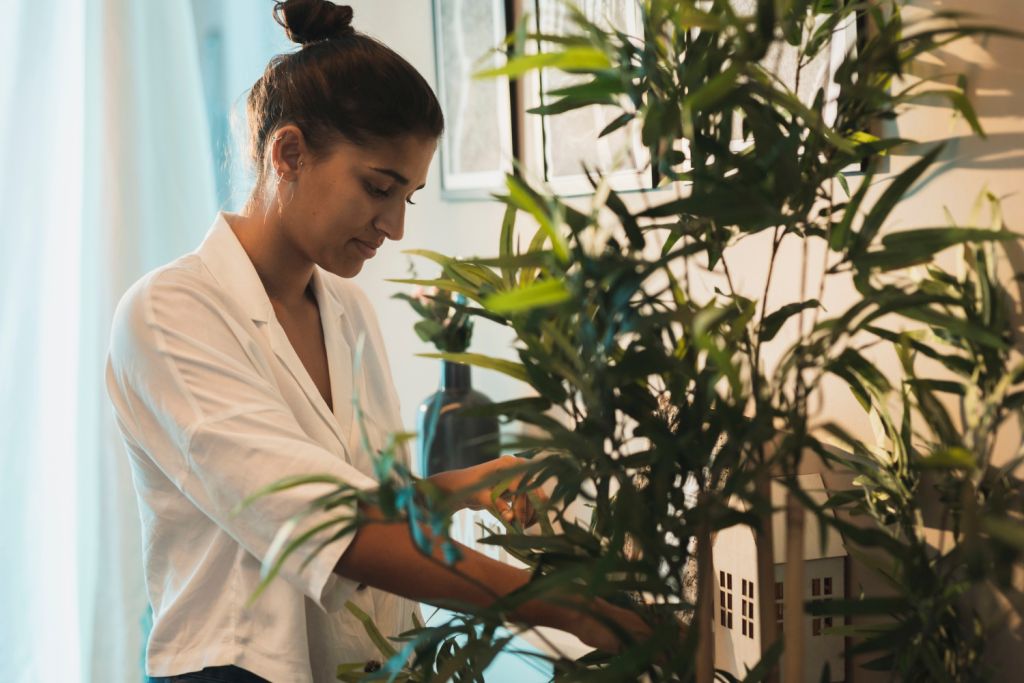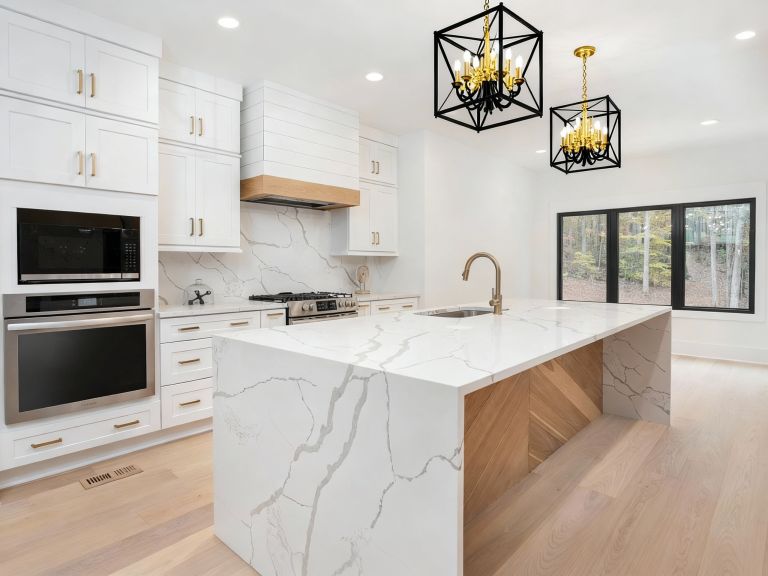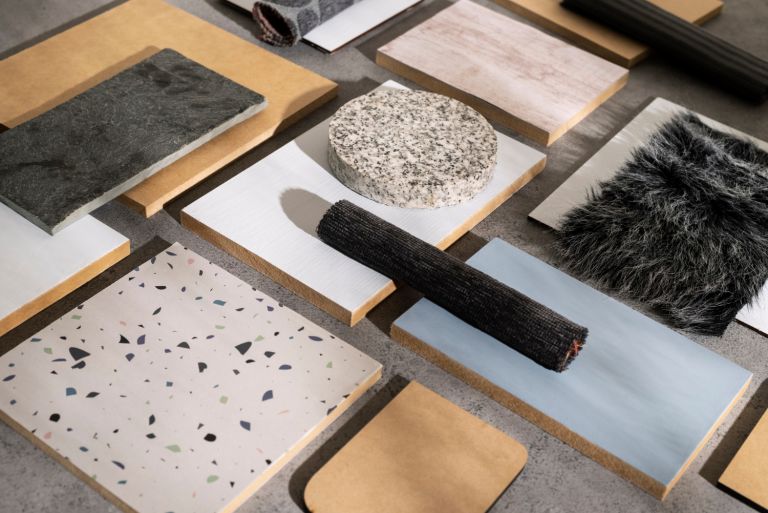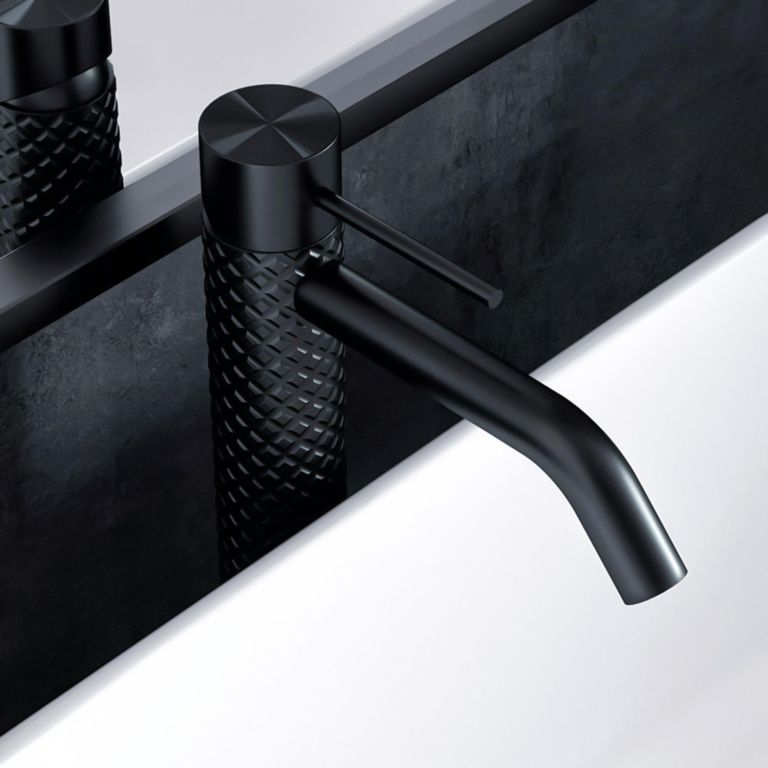The first time I walked through the Palo Alto home we’d just completed, I knew we’d created something extraordinary.
Sunlight streamed through clerestory windows onto a living wall that stretched 14 feet high. The sound of water trickling from a small fountain mixed with birdsong filtering through open windows designed to capture the hillside breeze. Natural limestone floors extended seamlessly from the kitchen to an outdoor courtyard where a Japanese maple cast dancing shadows.
The homeowner’s teenage daughter looked around and said, “It feels like we’re living in a forest, but with WiFi.”
That moment captured exactly why biophilic design has become more than a trend in the Bay Area – it’s become essential for how we want to live in 2025.
After completing over 180 biophilic design projects across the region, I’ve watched this approach transform from an interesting concept to a fundamental requirement for Bay Area homeowners seeking wellness, connection to nature, and spaces that support both productivity and restoration.
The science is clear: humans need nature. We spent 99% of our evolutionary history in natural environments, yet today we spend 90% of our time indoors. Biophilic design bridges this gap by bringing nature’s benefits inside through strategic use of natural light, materials, plants, water, and spatial patterns that mirror natural environments.
The Bay Area’s unique combination of environmental consciousness, tech-driven wellness focus, and extraordinary natural beauty creates perfect conditions for biophilic design implementation that goes far beyond simple plant placement or wood accents.
Let me show you exactly how thoughtful biophilic design can transform your Bay Area home into a space that doesn’t just shelter you from the world, but actively supports your health, creativity, and connection to the natural beauty that defines our region.
Understanding Biophilic Design Beyond the Basics
Biophilic design isn’t about decorating with plants – it’s a comprehensive approach to creating built environments that satisfy our innate human need for nature connection.
The concept, developed by biologist E.O. Wilson and expanded by environmental psychologists, recognizes that human wellbeing depends on our connection to natural systems, patterns, and processes.
The Science of Human-Nature Connection
Neurological research reveals measurable benefits when people interact with natural elements:
Stress reduction: Exposure to natural materials and patterns reduces cortisol levels by 15-25% within 15 minutes
Cognitive restoration: Views of nature improve concentration and reduce mental fatigue by 20-30%
Immune system support: Natural environments boost immune function through reduced stress and improved air quality
Sleep quality improvement: Natural light cycles and fresh air circulation support healthy circadian rhythms
Creativity enhancement: Natural environments increase innovative thinking by 50% compared to urban environments
Core Biophilic Design Elements
Direct nature connection:
- Living plants and green walls
- Water features and natural sounds
- Natural light and fresh air circulation
- Views of natural landscapes
Indirect nature connection:
- Natural materials like wood, stone, and clay
- Nature-inspired colors and patterns
- Natural shapes and forms rather than purely geometric designs
- Seasonal changes and natural aging processes
Spatial relationships:
- Spaces that provide both prospect (views) and refuge (protected areas)
- Natural ventilation and temperature variation
- Connections between indoor and outdoor environments
- Mystery and discovery through partially hidden views
Bay Area Advantages for Biophilic Design
Our region’s Mediterranean climate, environmental consciousness, and outdoor lifestyle create ideal conditions for implementing biophilic design principles year-round.
Climate Benefits
Year-round outdoor access: Mild temperatures allow extensive use of operable windows, outdoor living spaces, and indoor-outdoor integration
Abundant natural light: 260+ sunny days annually provide excellent daylighting opportunities without excessive heat gain
Natural cooling: Fog patterns and evening temperature drops reduce reliance on mechanical cooling systems
Extended growing seasons: Plants and gardens thrive year-round with minimal protection
Cultural Alignment
Environmental consciousness: Bay Area residents prioritize sustainability and natural living
Wellness focus: Strong cultural emphasis on health, mindfulness, and work-life balance
Outdoor lifestyle: Hiking, biking, and outdoor recreation create appreciation for nature connection
Innovation mindset: Openness to new approaches and technologies that support biophilic implementation
Natural Setting Integration
Diverse landscapes: From coastal redwoods to rolling hills, regional beauty provides inspiration and integration opportunities
Native plant communities: Rich selection of local plants adapted to our climate
Water features: Natural creeks, bay views, and seasonal rainfall patterns for integration
Seasonal variation: Subtle but meaningful seasonal changes that can be reflected indoors
Strategic Biophilic Design Implementation
Successful biophilic design requires integrating multiple natural elements to create layered sensory experiences rather than relying on single features.
Natural Light as Primary Design Driver
Daylighting strategies that support circadian rhythms and visual comfort:
South-facing clerestory windows:
- Provide consistent daylight without glare
- Create dramatic light patterns that change throughout the day
- Support winter heating through passive solar gain
- Cost: $800-2,000 per linear foot installed
Skylights with light wells:
- Bring natural light deep into interior spaces
- Create connection to sky and weather patterns
- Support plant growth in interior areas
- Automated shading systems prevent overheating
Light shelves and reflective surfaces:
- Bounce daylight deeper into rooms
- Reduce need for artificial lighting
- Create dynamic light patterns on walls and ceilings
- Integrate with architectural elements
Living Systems Integration
Plants serve multiple functions: air purification, humidity control, visual beauty, and psychological benefits.
Living wall systems:
- Dramatic green features that function as living art
- Automated irrigation with moisture sensors
- Native and drought-tolerant plant selection
- Cost: $60-150 per square foot installed
- Annual maintenance: $400-800 for typical residential installations
Indoor tree placement:
- Large plants that create canopy feeling indoors
- Improve air quality significantly
- Provide privacy screening
- Connect to outdoor landscape views
Edible plant integration:
- Herb gardens in kitchen areas
- Fruit trees in courtyards
- Connection to farm-to-table Bay Area culture
- Educational opportunity for families
Natural Materials and Textures
Material selection that connects to regional geology and plant communities:
Reclaimed wood applications:
- Bay Area redwood and Douglas fir with historical connection
- Live-edge slabs for organic shapes
- Varied grain patterns and natural imperfections
- Aging gracefully over time
Local stone integration:
- Sonoma fieldstone for walls and water features
- Santa Barbara sandstone for warm earth tones
- Natural cleft surfaces for texture variation
- Connection to regional geological character
Clay and earth materials:
- Tile and pottery from local artisans
- Adobe and rammed earth construction elements
- Terra cotta planters and architectural details
- Natural color variations and handmade character
Water Feature Integration
Water provides sound masking, humidity, and psychological benefits:
Fountain and stream elements:
- Natural stone construction
- Recirculating systems for water conservation
- Plant integration for natural appearance
- LED lighting for evening ambiance
Reflecting pools:
- Mirror sky and surrounding landscape
- Support wildlife like birds and beneficial insects
- Create meditation and contemplation spaces
- Integrate with irrigation systems
Rain collection and display:
- Rain chains and collection systems
- Seasonal water display during Bay Area winters
- Educational component about water cycles
- Integration with landscape irrigation
Room-by-Room Biophilic Applications
Different spaces benefit from specific biophilic strategies based on their function and usage patterns.
Living Areas: Social Biophilia
Creating spaces that support both social interaction and nature connection:
Indoor-outdoor integration:
- Large sliding doors that completely open
- Continuous flooring materials from inside to outside
- Outdoor furniture that coordinates with indoor pieces
- Weather protection through overhangs and screens
Natural gathering spaces:
- Fireplaces with natural stone surrounds
- Seating arrangements that face garden views
- Coffee tables from live-edge wood slabs
- Plants at varying heights to create layered green environments
Kitchens: Functional Biophilia
Integrating nature into the most active family space:
Herb and food gardens:
- Window-mounted growing systems
- Countertop herb planters
- View connections to outdoor vegetable gardens
- Integration with meal preparation workflow
Natural materials:
- Wood cutting surfaces and utensils
- Stone countertops with natural variation
- Clay and ceramic serving pieces
- Copper and brass accents that develop patina
Bedrooms: Restorative Biophilia
Supporting sleep and recovery through nature connection:
Air quality optimization:
- Bedroom plants that produce oxygen at night (snake plants, aloe)
- Natural fiber bedding and textiles
- Organic mattresses and pillows
- Cross-ventilation for fresh air circulation
Circadian rhythm support:
- East-facing windows for natural wake-up light
- Automated blinds that adjust to sunrise/sunset
- Natural materials that don’t off-gas
- Connection to outdoor sounds like wind and birds
Home Offices: Productive Biophilia
Enhancing focus and creativity through strategic nature integration:
Green sight lines:
- Desk placement with views of plants or gardens
- Living walls visible from work areas
- Natural light from multiple directions
- Plants that improve air quality during long work sessions
Natural materials:
- Wood desk surfaces and storage
- Stone or clay decorative elements
- Natural fiber rugs and textiles
- Furniture that connects to outdoor craftsmanship traditions
Cost-Effective Biophilic Implementation
Biophilic design can be implemented at various investment levels while maintaining authentic nature connection.
Budget-Conscious Approaches ($2,000-8,000)
High-impact, lower-cost strategies:
Window and door upgrades:
- Replacing solid doors with French doors
- Adding windows or enlarging existing ones
- Installing operable windows for natural ventilation
- Window boxes and exterior planters
Plant integration:
- Strategic placement of air-purifying plants
- Seasonal plant rotation systems
- DIY living wall installations
- Container gardens for flexibility
Natural materials:
- Reclaimed wood accent walls
- Natural fiber area rugs
- Stone or clay decorative elements
- Organic paint colors inspired by nature
Comprehensive Integration ($15,000-50,000)
Whole-room or multiple-room biophilic transformation:
Architectural modifications:
- Skylight installation
- Interior courtyard creation
- Living wall systems with irrigation
- Natural material flooring
System integration:
- Automated plant care systems
- Natural ventilation improvements
- Water feature installation
- Comprehensive lighting design
Premium Biophilic Homes ($75,000-200,000)
Complete integration with architectural design:
Structural biophilia:
- Glass roof sections or atriums
- Interior water features with natural filtration
- Custom millwork from sustainable materials
- Integrated growing systems throughout
Landscape integration:
- Professional landscape design
- Outdoor kitchen and living spaces
- Pool and spa integration
- Native plant restoration
Maintenance and Longevity Considerations
Successful biophilic design requires planning for long-term care and system maintenance.
Plant Care Systems
Automated irrigation:
- Moisture sensors that adjust watering based on plant needs
- Seasonal adjustments for dormancy periods
- Backup systems for vacation or extended absence
- Integration with smart home systems
Professional maintenance:
- Monthly plant care service: $150-400
- Seasonal plant replacement budget: $500-1,500
- Living wall maintenance: $200-600 monthly
- Pest and disease management protocols
Material Maintenance
Natural material care:
- Wood oiling and refinishing schedules
- Stone sealing and cleaning protocols
- Water feature maintenance and winterization
- Seasonal plant protection and pruning
System longevity:
- Quality installation for 20+ year lifespan
- Component replacement planning
- Technology updates for smart systems
- Sustainable material sourcing for repairs
Real Project Example: Menlo Park Biophilic Transformation
Complete renovation showcasing comprehensive biophilic design implementation:
Project scope: 2,800 sq ft ranch home transformation
Timeline: 8 months design and construction
Investment: $185,000 comprehensive renovation
Biophilic elements integrated:
Natural light optimization:
- Added 8 skylights throughout home
- Enlarged south-facing windows by 40%
- Installed clerestory windows in main living area
- Created interior courtyard with glass roof
Living systems:
- 12×8 foot living wall in entry area
- Kitchen herb garden with grow lights
- Master bathroom with air-purifying plants
- Outdoor vegetable garden visible from kitchen
Water feature integration:
- Interior fountain in entry courtyard
- Outdoor stream connecting to rain collection
- Reflecting pool in meditation garden
- Hot tub integrated with landscape design
Natural materials:
- Reclaimed redwood ceiling beams throughout
- Local fieldstone flooring in main areas
- Live-edge dining table from fallen oak
- Clay tile work by local artisans
Results measured after one year:
- Family stress levels decreased 30% (measured through surveys)
- Sleep quality improved significantly (sleep tracking data)
- Home entertainment increased 60%
- Energy bills decreased 25% through passive heating/cooling
- Property value increased $95,000 above renovation costs
Final Results
Biophilic design creates Bay Area homes that actively support human wellbeing while connecting families to the natural beauty that defines our region.
Successful biophilic projects typically achieve:
- 20-40% improvement in reported stress levels and sleep quality
- Enhanced creativity and productivity in home office environments
- Stronger family connection to outdoor activities and nature appreciation
- 15-30% reduction in energy costs through passive heating, cooling, and lighting
- 8-20% increase in home value through sophisticated, health-focused design
- Improved indoor air quality through plant-based filtration systems
The key to success is integrating multiple biophilic elements that work together to create authentic nature connections rather than superficial green decoration.
Conclusion
Biophilic design isn’t a trend – it’s a return to the natural living environments that support human flourishing.
In the Bay Area’s unique combination of environmental consciousness, wellness focus, and natural beauty, biophilic homes represent the evolution of sustainable design from simply “doing less harm” to actively supporting human and environmental health.
The most successful projects feel effortless and natural while providing measurable improvements in family wellbeing, home performance, and connection to the extraordinary natural environment that makes Bay Area living special.
For families seeking homes that support both productivity and restoration, biophilic design offers a proven approach to creating spaces that feel alive, healthy, and authentically connected to the natural world.
The investment in biophilic design pays dividends through enhanced daily quality of life, reduced stress, improved health outcomes, and homes that feel like personal retreats rather than just functional shelters.






